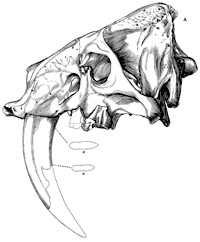Museum, University of Nebraska State

Bulletin of the University of Nebraska State Museum (1924–2023)
Date of this Version
2-1975
Document Type
Article
Citation
BULLETIN OF THE UNIVERSITY OF NEBRASKA STATE MUSEUM, VOLUME 10, NUMBER 1, PART 5 FEBRUARY, 1975, PP.55-63, Frontispiece, Figs. 1-5
Abstract
"Machairodus catocopis Cope" is shown to be a pseudaelurin cat belonging to the genus Nimravides Kitts. Nimravides thinobates (Macdonald) is a possible synonym of N. catocopis (Cope). Nimravides is compared with the Eurasian Machairodus-like cat, Dinofelis. Machairodus (Heterofelis) coloradensis is reported from the Kimball Formation, upper Pliocene (Kimballian) of Cheyenne County, Nebraska, and from the upper part of the Ash Hollow Formation, Pliocene (Hemphillian) of Sherman County, Nebraska. The Kimballian form is described as a new subspecies, Machairodus coloradensis tanneri.
The genus Machairodus has long been associated with the Hemphillian of North America and the Pontian of Eurasia. It was first reported from North America when Cope, in 1887, described a partial symphysis of a mandible from the Pliocene of Kansas as Machairodus catocopis. He did not illustrate this specimen, and it has largely been ignored (see Fig. 3, C and E in the present paper). The concept of the species has rather been based on abundant material from Ogallala deposits (Hemphillian) of Yuma County, Colorado, described by Cook (1922) as M. (Heterofelis) coloradensis; later Burt (1931) published additional records from the Hemphillian of Texas. Matthew (1924) placed M. coloradensis in synonomy with M. catocopis and this concept has generally been followed. New material from Smith County, Kansas, which is near the type locality and horizon of M. Catocopis, permits a reevaluation of that species and shows that it is a pseudaelurin cat, Nimravides. Machairodus coloradensis is reported from the Upper Ash Hollow deposits (Hemphillian) of Sherman County, Nebraska, and is compared to a new subspecies of Machairodus described in this paper from the Kimball (Kimballian) Formation of Cheyenne County, Nebraska. This new subspecies demonstrates evolutionary trends which seem to be leading to Ischyrosmilus from the lower Quaternary (Blancan). We do not regard the pseudaelurin cats to be of subfamily rank, although they probably should be placed in a separate tribe, Pseudaelurini, which represents primitive felines.
Included in
Entomology Commons, Geology Commons, Geomorphology Commons, Other Ecology and Evolutionary Biology Commons, Paleobiology Commons, Paleontology Commons, Sedimentology Commons


Comments
Copyright (c) 1975 University of Nebraska